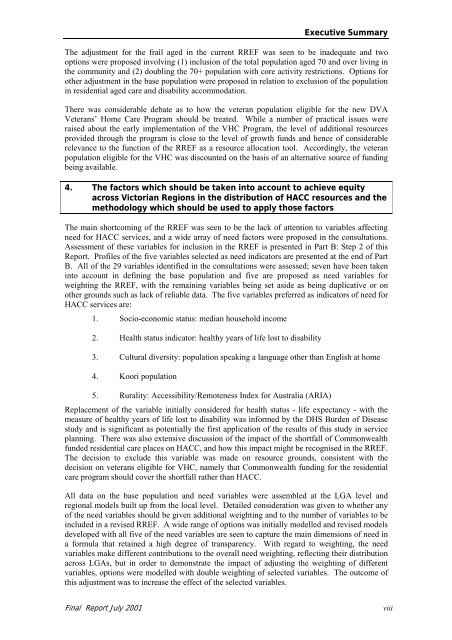Final Report on RREF 2001 - Department of Health
Final Report on RREF 2001 - Department of Health
Final Report on RREF 2001 - Department of Health
Create successful ePaper yourself
Turn your PDF publications into a flip-book with our unique Google optimized e-Paper software.
Executive Summary<br />
The adjustment for the frail aged in the current <strong>RREF</strong> was seen to be inadequate and two<br />
opti<strong>on</strong>s were proposed involving (1) inclusi<strong>on</strong> <strong>of</strong> the total populati<strong>on</strong> aged 70 and over living in<br />
the community and (2) doubling the 70+ populati<strong>on</strong> with core activity restricti<strong>on</strong>s. Opti<strong>on</strong>s for<br />
other adjustment in the base populati<strong>on</strong> were proposed in relati<strong>on</strong> to exclusi<strong>on</strong> <strong>of</strong> the populati<strong>on</strong><br />
in residential aged care and disability accommodati<strong>on</strong>.<br />
There was c<strong>on</strong>siderable debate as to how the veteran populati<strong>on</strong> eligible for the new DVA<br />
Veterans’ Home Care Program should be treated. While a number <strong>of</strong> practical issues were<br />
raised about the early implementati<strong>on</strong> <strong>of</strong> the VHC Program, the level <strong>of</strong> additi<strong>on</strong>al resources<br />
provided through the program is close to the level <strong>of</strong> growth funds and hence <strong>of</strong> c<strong>on</strong>siderable<br />
relevance to the functi<strong>on</strong> <strong>of</strong> the <strong>RREF</strong> as a resource allocati<strong>on</strong> tool. Accordingly, the veteran<br />
populati<strong>on</strong> eligible for the VHC was discounted <strong>on</strong> the basis <strong>of</strong> an alternative source <strong>of</strong> funding<br />
being available.<br />
4. The factors which should be taken into account to achieve equity<br />
across Victorian Regi<strong>on</strong>s in the distributi<strong>on</strong> <strong>of</strong> HACC resources and the<br />
methodology which should be used to apply those factors<br />
The main shortcoming <strong>of</strong> the <strong>RREF</strong> was seen to be the lack <strong>of</strong> attenti<strong>on</strong> to variables affecting<br />
need for HACC services, and a wide array <strong>of</strong> need factors were proposed in the c<strong>on</strong>sultati<strong>on</strong>s.<br />
Assessment <strong>of</strong> these variables for inclusi<strong>on</strong> in the <strong>RREF</strong> is presented in Part B: Step 2 <strong>of</strong> this<br />
<str<strong>on</strong>g>Report</str<strong>on</strong>g>. Pr<strong>of</strong>iles <strong>of</strong> the five variables selected as need indicators are presented at the end <strong>of</strong> Part<br />
B. All <strong>of</strong> the 29 variables identified in the c<strong>on</strong>sultati<strong>on</strong>s were assessed; seven have been taken<br />
into account in defining the base populati<strong>on</strong> and five are proposed as need variables for<br />
weighting the <strong>RREF</strong>, with the remaining variables being set aside as being duplicative or <strong>on</strong><br />
other grounds such as lack <strong>of</strong> reliable data. The five variables preferred as indicators <strong>of</strong> need for<br />
HACC services are:<br />
1. Socio-ec<strong>on</strong>omic status: median household income<br />
2. <strong>Health</strong> status indicator: healthy years <strong>of</strong> life lost to disability<br />
3. Cultural diversity: populati<strong>on</strong> speaking a language other than English at home<br />
4. Koori populati<strong>on</strong><br />
5. Rurality: Accessibility/Remoteness Index for Australia (ARIA)<br />
Replacement <strong>of</strong> the variable initially c<strong>on</strong>sidered for health status - life expectancy - with the<br />
measure <strong>of</strong> healthy years <strong>of</strong> life lost to disability was informed by the DHS Burden <strong>of</strong> Disease<br />
study and is significant as potentially the first applicati<strong>on</strong> <strong>of</strong> the results <strong>of</strong> this study in service<br />
planning. There was also extensive discussi<strong>on</strong> <strong>of</strong> the impact <strong>of</strong> the shortfall <strong>of</strong> Comm<strong>on</strong>wealth<br />
funded residential care places <strong>on</strong> HACC, and how this impact might be recognised in the <strong>RREF</strong>.<br />
The decisi<strong>on</strong> to exclude this variable was made <strong>on</strong> resource grounds, c<strong>on</strong>sistent with the<br />
decisi<strong>on</strong> <strong>on</strong> veterans eligible for VHC, namely that Comm<strong>on</strong>wealth funding for the residential<br />
care program should cover the shortfall rather than HACC.<br />
All data <strong>on</strong> the base populati<strong>on</strong> and need variables were assembled at the LGA level and<br />
regi<strong>on</strong>al models built up from the local level. Detailed c<strong>on</strong>siderati<strong>on</strong> was given to whether any<br />
<strong>of</strong> the need variables should be given additi<strong>on</strong>al weighting and to the number <strong>of</strong> variables to be<br />
included in a revised <strong>RREF</strong>. A wide range <strong>of</strong> opti<strong>on</strong>s was initially modelled and revised models<br />
developed with all five <strong>of</strong> the need variables are seen to capture the main dimensi<strong>on</strong>s <strong>of</strong> need in<br />
a formula that retained a high degree <strong>of</strong> transparency. With regard to weighting, the need<br />
variables make different c<strong>on</strong>tributi<strong>on</strong>s to the overall need weighting, reflecting their distributi<strong>on</strong><br />
across LGAs, but in order to dem<strong>on</strong>strate the impact <strong>of</strong> adjusting the weighting <strong>of</strong> different<br />
variables, opti<strong>on</strong>s were modelled with double weighting <strong>of</strong> selected variables. The outcome <strong>of</strong><br />
this adjustment was to increase the effect <strong>of</strong> the selected variables.<br />
<str<strong>on</strong>g>Final</str<strong>on</strong>g> <str<strong>on</strong>g>Report</str<strong>on</strong>g> July <strong>2001</strong><br />
viii
















